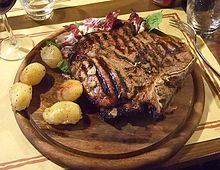This article needs additional citations for verification. (April 2024) |
Bistecca alla fiorentina (lit. 'beefsteak Florentine style') is an Italian steak dish made of young steer (vitellone) or heifer (scottona) that is one of the most famous dishes in Tuscan cuisine. It is loin steak on the bone cooked on a grill until rare (50 °C).
 | |
| Alternative names | Beefsteak Florentine style |
|---|---|
| Place of origin | Italy |
| Region or state | Tuscany |
| Cooking time | 11 minutes to 17 minutes |
| Serving temperature | Hot |
| Main ingredients | Beef |
History edit
The word bistecca was borrowed from the English beefsteak in the early 19th century.[1] An 1863 dictionary defines it as:
...una large fetta di carne, tagliata dalla culatta o d'altronde, poco arrostito sulla gratella, or altramente, e che si mangia così guascotta.
...a large slice of meat, cut from the rump or elsewhere, lightly cooked on a grill or otherwise, and eaten undercooked.[1]
Definition edit
Bistecca alla fiorentina is obtained from the cut of the sirloin (the part corresponding to the lumbar vertebrae, the half of the back on the side of the tail) of a young steer or heifer of the Chianina breed: in the middle it has the T-shaped bone, that is, a T-bone steak, with the fillet on one side and the sirloin on the other.
The Italian gastronomist Pellegrino Artusi, in his 1891 cooking manual Science in the Kitchen and the Art of Eating Well (La scienza in cucina e l'arte di mangiar bene), defines the cut of the steak as follows: "Florentine steak. From beef-steak, an English word that is worth the rib of an ox, came the name of our steak, which is nothing more than a chop with its bone, a finger or a finger and a half thick, cut from the sirloin of a steer."[2]
Preparation edit
The meat – previously aged for at least two weeks in cold rooms – must be at room temperature at the time of cooking. The cut is about 1–1.5 kg, the height about 5–6 cm.
To heat the grill, a generous amount of charcoal embers, preferably oak, holm oak or olive, is used. The charcoal must be well alive, barely veiled by a light layer of ash, without flame. The meat must be very close to the coals, at first, so that an aromatic crust is formed as quickly as possible via the Maillard reaction, then after the first minute it must be raised to a gentler heat.
The unseasoned meat is turned once, cooking it about 3–5 minutes per side. Finally, it is cooked "standing" on the side of the bone (the steak must be thick enough to stand alone), for 5/7 minutes, until the traces of juice disappear from the bone.[citation needed]
The meat is well browned on the outside and rare on the inside. It should be red, soft, and juicy on the inside, but also warm. For this reason, it is not turned with forks.
Traditional accompaniments are cannellini beans dressed in olive oil, or a salad. On the table, it goes well with a good red wine, like Chianti classico.
See also edit
Media related to Bistecca alla fiorentina at Wikimedia Commons
- List of beef dishes
- Italian Nettist Party, also known as the Steak Party
- T-bone steak
References edit
- ^ a b Fanfani, Pietro (1863). Vocabolario dell'uso toscano: Compilato da Pietro Fanfani (in Italian). G. Barbèra. pp. 154, s.v. bistécca.
- ^ Pellegrino Artusi (2003). La scienza in cucina e l'arte di mangiar bene. Florence: Giunti. ISBN 978-88-09-03190-6.
Bibliography edit
- Regione Toscana (a cura di), Viaggio in Toscana. Alla scoperta dei prodotti tipici, Firenze, Giunti, 2001, p. 127. ISBN 978-88-09-02452-6.
- Paolo Petroni, Il libro della vera cucina fiorentina, Firenze, Il Centauro, 2004. ISBN 978-88-86540-01-8.
- Sandro Pintus, Elogio della bistecca. La fiorentina dalla Chianina alla tavola. Storia, ricette, curiosità, 2ª edizione, StreetLib, 2016. Windows/Linux. ISBN 9786050436051 – Mac (interattivo) id1027888456.